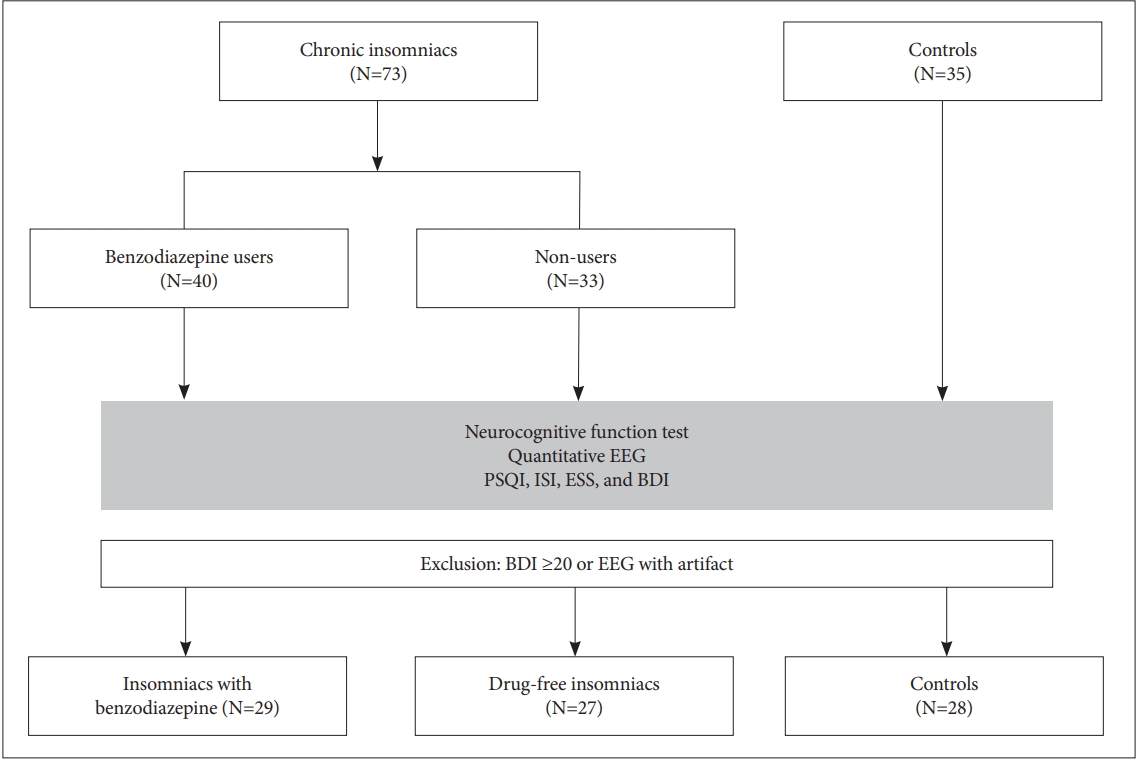1. Ohayon MM. Epidemiology of insomnia: what we know and what we still need to learn. Sleep Med Rev 2002;6:97-111.


2. Laugsand LE, Vatten LJ, Platou C, Janszky I. Insomnia and the risk of acute myocardial infarction: a population study. Circulation 2011;124:2073-2081.


4. Baglioni C, Battagliese G, Feige B, Spiegelhalder K, Nissen C, Voderholzer U, et al. Insomnia as a predictor of depression: a meta-analytic evaluation of longitudinal epidemiological studies. J Affect Disord 2001;135:10-19.

6. Paller KA, Creery JD, Schechtman E. Memory and sleep: how sleep cognition can change the waking mind for the better. Annu Rev Psychol 2021;72:123-150.


7. Yaffe K, Falvey CM, Hoang T. Connections between sleep and cognition in older adults. Lancet Neurol 2014;13:1017-1028.


11. Barker MJ, Greenwood KM, Jackson M, Crowe SF. Cognitive effects of long-term benzodiazepine use: a meta-analysis. CNS Drugs 2004;18:37-48.


12. Riemann D, Baglioni C, Bassetti C, Bjorvatn B, Dolenc Groselj L, Ellis JG, et al. European guideline for the diagnosis and treatment of insomnia. J Sleep Res 2017;26:675-700.


13. Hauk L. Treatment of chronic insomnia in adults: ACP guideline. Am Fam Physician 2017;95:669-670.

14. Ohayon MM, Caulet M. Psychotropic medication and insomnia complaints in two epidemiological studies. Can J Psychiatry 1996;41:457-464.


15. Neutel CI. The epidemiology of long-term benzodiazepine use. Int Rev Psychiatry 2005;17:189-197.


16. Morin CM, Bélanger L, Bernier F. Correlates of benzodiazepine use in individuals with insomnia. Sleep Med 2004;5:457-462.


17. Stewart SA. The effects of benzodiazepines on cognition. J Clin Psychiatry 2005;66 Suppl 2:9-13.

19. Coutin-Churchman P, Añez Y, Uzcátegui M, Alvarez L, Vergara F, Mendez L, et al. Quantitative spectral analysis of EEG in psychiatry revisited: drawing signs out of numbers in a clinical setting. Clin Neurophysiol 2003;114:2294-2306.


21. Perlis ML, Merica H, Smith MT, Giles DE. Beta EEG activity and insomnia. Sleep Med Rev 2001;5:363-374.

22. Perlis ML, Smith MT, Andrews PJ, Orff H, Giles DE. Beta/Gamma EEG activity in patients with primary and secondary insomnia and good sleeper controls. Sleep 2001;24:110-117.


24. Hamida ST, Penzel T, Ahmed B. EEG time and frequency domain analyses of primary insomnia. Annu Int Conf IEEE Eng Med Biol Soc 2015;2015:6206-6209.


25. American Academy of Sleep Medicine. International classification of sleep disorders. 3rd ed. Darien: American Academy of Sleep Medicine; 2014, p. 21-22.
27. Johns MW. A new method for measuring daytime sleepiness: the Epworth sleepiness scale. Sleep 1991;14:540-545.


28. Beck AT, Steer RA, Brown GK. Beck depression inventory (2nd ed). San Antonio: The Psychological Corporation; 1996.
29. Lee DY, Lee KU, Lee JH, Kim KW, Jhoo JH, Kim SY, et al. A normative study of the CERAD neuropsychological assessment battery in the Korean elderly. J Int Neuropsychol Soc 2004;10:72-81.


30. Petersen RC. Mild cognitive impairment as a diagnostic entity. J Intern Med 2004;256:183-194.


31. Wu CS, Wang SC, Chang IS, Lin KM. The association between dementia and long-term use of benzodiazepine in the elderly: nested case-control study using claims data. Am J Geriatr Psychiatry 2009;17:614-620.


32. Wu CS, Ting TT, Wang SC, Chang IS, Lin KM. Effect of benzodiazepine discontinuation on dementia risk. Am J Geriatr Psychiatry 2011;19:151-159.


33. World Health Organization. WHO collaborating centre for drug statistics methodology: guidelines for ATC classification and DDD assignment. Geneva: World Health Organization; 2009.
34. Crowe SF, Stranks EK. The residual medium and long-term cognitive effects of benzodiazepine use: an updated meta-analysis. Arch Clin Neuropsychol 2018;33:901-911.


36. Mura T, Proust-Lima C, Akbaraly T, Amieva H, Tzourio C, Chevassus H, et al. Chronic use of benzodiazepines and latent cognitive decline in the elderly: results from the three-city study. Eur Neuropsychopharmacol 2013;23:212-223.


37. Del Ser T, Zea MA, Valentí M, Olazarán J, López-Álvarez J, Rebollo- Vázquez A, et al. Effects of commonly prescribed drugs on cognition and mild cognitive impairment in healthy elderly people. J Psychopharmacol 2019;33:965-974.


38. Helmes E, Østbye T. Associations between benzodiazepine use and neuropsychological test scores in older adults. Can J Aging 2015;34:207-214.


40. Budson AE, Kowall NW. The handbook of Alzheimer’s disease and other dementias. Hoboken: Wiley-Blackwell; 2014.
41. Kehagia AA, Barker RA, Robbins TW. Neuropsychological and clinical heterogeneity of cognitive impairment and dementia in patients with Parkinson’s disease. Lancet Neurol 2010;9:1200-1213.


42. Pillai V, Roth T, Roehrs T, Moss K, Peterson EL, Drake CL. Effectiveness of benzodiazepine receptor agonists in the treatment of insomnia: an examination of response and remission rates. Sleep 2017;40:zsw044


43. Mendelsohn AR, Larrick JW. Sleep facilitates clearance of metabolites from the brain: glymphatic function in aging and neurodegenerative diseases. Rejuvenation Res 2013;16:518-523.


45. Fan TT, Chen WH, Shi L, Lin X, Tabarak S, Chen SJ, et al. Objective sleep duration is associated with cognitive deficits in primary insomnia: BDNF may play a role. Sleep 2019;42:zsy192

47. Pariente A, de Gage SB, Moore N, Bégaud B. The benzodiazepine-dementia disorders link: current state of knowledge. CNS Drugs 2016;30:1-7.


48. Dingemanse J, Häussler J, Hering W, Ihmsen H, Albrecht S, Zell M, et al. Pharmacokinetic-pharmacodynamic modelling of the EEG effects of Ro 48-6791, a new short-acting benzodiazepine, in young and elderly subjects. Br J Anaesth 1997;79:567-574.


49. Carskadon MA, Dement WC, Mitler MM, Guilleminault C, Zarcone VP, Spiegel R. Self-reports versus sleep laboratory findings in 122 drugfree subjects with complaints of chronic insomnia. Am J Psychiatry 1976;133:1382-1388.


50. Baker FC, Maloney S, Driver HS. A comparison of subjective estimates of sleep with objective polysomnographic data in healthy men and women. J Psychosom Res 1999;47:335-341.


51. Michail E, Chouvarda I, Maglaveras N. Benzodiazepine administration effect on EEG fractal dimension: results and causalities. Annu Int Conf IEEE Eng Med Biol Soc 2010;2010:2350-2353.


53. Bastien CH, LeBlanc M, Carrier J, Morin CM. Sleep EEG power spectra, insomnia, and chronic use of benzodiazepines. Sleep 2003;26:313-317.


54. Fernandez-Mendoza J, He F, Puzino K, Amatrudo G, Calhoun S, Liao D, et al. Insomnia with objective short sleep duration is associated with cognitive impairment: a first look at cardiometabolic contributors to brain health. Sleep 2021;44:zsaa150


55. Perlis ML. Response to “do increases in beta EEG activity uniquely reflect insomnia?” (C. H. Bastein and M. H. Bonnet). Sleep Med Rev 2001;5:379-383.













